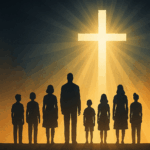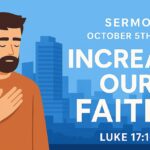“Above All Else : Holy Baptism” – Galatians 3:26-27
1. Stories of being saved / rescued
True stories of people being saved or rescued are fascinating, captivating. If you are old enough, you probably remember Alex Haley’s 1976 best-seller Roots and the 1977 TV mini-series by the same name. Its subtitle was “The Saga of an American Family.” But the story starts some 200 years earlier… with an African family, not an American one, and it’s not initially the story of a rescue but of a capture. Kunta Kinte, a teenager, was captured by British slave traders while he was out and about from his village near the Gambia River, and he was taken across the Atlantic to Maryland where he was purchased by a plantation owner in Virginia. The story follows 7 generations of the family, including an eventual “escape” or “rescue” from slavery. Roots takes us all the way down to Alex Haley, the author.
I wish I knew some stories from my family history like that. I do know that my ancestors left the old country – a German colony in western Ukraine – in the late 1800’s and they traveled by ship across the Atlantic until they arrived in Canada and then homesteaded in eastern Saskatchewan in the late 1890’s. I don’t think my paternal great-grandfather passed along many stories of life in the old country and of the journey across the Atlantic, never to return, and of what it was like to settle in a new, never-been-here-before land. My maternal great-grandmother – the one whose seal-skin fur coat teddy bear I showed last Sunday – did pass along some of her stories in a book entitled Maria’s Memories. My pastor uncle has also written some church history books which document the migration of those German colonies to Canada – not specifically my relatives, but certainly including my relatives. So, I can appreciate and understand how they were “rescued” from the harsh conditions in Ukraine and how they made the best of the harsh conditions in Canada.
Corrie Ten Boom was a Dutch watch-maker, who along with her watch-maker father and her sister hid / “rescued” many Jewish people during World War II. In their home above the watch-maker shop, they built a secret room with a false wall in the back of Corrie’s bedroom. When the German Gestapo came for random security sweeps, they quickly hid the Jewish people they were hosting in that secret room. It is estimated that they saved as many as 800 people. All of this is documented in Ten Boom’s book The Hiding Place and the subsequent movie of the same name.
I wonder how many similar stories have been told or will be told in the months to come by Ukrainian individuals / families who have fled the war in their home towns and country. Those stories will be no less captivating and heart-wrenching.
There are some Bible stories of rescue, too, like the one of Joseph and Mary leaving Bethlehem at night with baby Jesus and traveling to Egypt to be saved from a hateful king dedicated to snuffing out any potential rival kings, even if they were still just babies or toddlers.
2. The Passover
Let me spend a little more time on another “rescue” story and then draw out its application for our lives. Oh, and this fits into our sermon series consideration of the essentials of our faith.
Every year at the same time, in fact on the same night, a lot of families gathered for a meal to verbally rehearse their rescue story, to make sure that the next generation would hear about it and be able to tell it to their children and grandchildren. It was the Passover. The people were the Jews, of Jesus’ time, but the story was from almost 1500 years earlier. The story goes like this…
After Joseph had been sold into slavery in Egypt, he rose to prominence as second only to the Egyptian pharaoh. During a time of famine, his father Jacob and all his brothers and their families came to live in Egypt. They were initially honoured because they were Joseph’s family members, but eventually they were relegated to slavery. After some 400 years in Egypt, God raised up Moses to “rescue” the Israelites and to lead God’s people back to the land He had promised them. God sent 10 plagues on Egypt to convince the pharaoh to let the Israelites go. The last plague would be the death of the first-born in Egypt. But the Israelites had an “escape clause.” They were to sacrifice a perfect, spotless lamb and to spread its blood on the doorframes of their homes. Then the angel of death would “pass over” their home and spare their first-born children. At the same time they were to eat the lamb and some other specific ingredients that would remind them of certain aspects of their time in Egypt. That meal would come to be known as the Passover. It was the meal that was celebrated in every home, every year on the same night, with the same menu, and with the retelling of that great “rescue story” from the time of Moses so that future generations would know it and would put their trust in that same God of their deliverance.
And so it was that even Jesus and His disciples met to share that Passover story and the Passover meal that went along with it. Instead of the normal celebration within the context of an extended multi-generational family, they met together as friends. They would have eaten the same foods as families did for the past 1000 years or so. However, on this night, Jesus took the unleavened matza bread – unleavened to recall the fact that the ancient Israelites didn’t have time for bread made with yeast to rise – Jesus took that bread and said some different words: “This is my body… take it, eat it.” And then He took the cup, which represented one of the four promises that God made to His ancient people, and Jesus said some different words again: “Take and drink… This cup is the new covenant in my blood, poured out for you for the forgiveness of your sins.” His words were foreshadowing a new rescue story that would take place some 18 hours later as His own body – perfect and spotless like the ancient lambs – was broken and His own blood was spilled as He suffered and died on the cross for us, to forgive us. Now, we continue telling that new rescue story and eating that new special meal – Holy Communion – remembering and rejoicing that the angel of eternal death will pass over us because the blood of Jesus covers our hearts and lives just like the blood of the Passover lamb covered the doorframes of the Israelite homes in Egypt.
3. Holy Communion – a Sacrament
As we consider this “new special meal” as an essential of our faith, we want to first consider that, like Baptism, Holy Communion is a Sacrament. Sacrament is simply a Latin term for a “sacred rite or action.” That means three things:
It was instituted by the Lord. That is self-evident by the fact that Jesus changed the words and the meaning of the meal to connect with what would be happening the very next day. And He also commanded His disciples – not just those first century disciples but His disciples of all times, including us – He commanded us “Do this in remembrance of me.”
The second thing is that it connects God’s Word and promise with a visible earthly element. In Holy Baptism it was water, and God’s Word gave water its power to bring about new spiritual birth and to cleanse us on the inside. In Holy Communion the earthly elements are bread and wine, and God’s Word gives those elements power to sustain and nourish us in our spirits.
The third thing is that we receive forgiveness of sins, God’s grace. Again that is clear by Jesus’ own words: “This is my blood of the new covenant, poured out for you for the forgiveness of sins.” When you come to the Lord’s table, you come in repentance and with faith. When you leave, you leave with the load of your sins completely removed. Medicine is for the sick who want to be healed. The Lord’s Supper is for sinners who desire to be forgiven for their sin. You can leave the Lord’s table, you can leave the building with contentment, and with joy! God is gracious!
4. Holy Communion – the “Real Presence”
Within the broad spectrum of world-wide Christendom, there are differing views of what we receive in Holy Communion. One view is that the bread changes into the body of Christ so that, even though it looks like bread, no bread remains… only the body of Christ. In the same way also the wine changes into the blood of Christ – no wine, only blood of Christ. In that sense, there is great mystery in the Lord’s Supper. Another view can’t fathom that great a mystery, and so it takes ALL the mystery out of it by explaining to help people rationally and reasonably understand what is offered and given. This is what is known as a symbolic presence – the bread symbolizes the body of Christ, the wine represents the blood of Christ. By this understanding, recipients receive only bread and wine (or often grape juice).
Martin Luther wanted to retain the mystery associated with Holy Communion. He didn’t feel the need to rationally explain things away. He did want to remain true to Scripture and Jesus’ own words, and nowhere did he see the Bible speak of a change in the substance. He was left with taking Jesus’ words at face value. Where he saw the word “IS” he saw an equal sign. “This bread IS (that is, EQUALS) my body. This cup IS (that is, EQUALS) my blood of the new covenant.” He saw a danger in saying either less or more than what Jesus actually said. He could not accept that the bread was LESS THAN Jesus’ body, nor was the wine LESS THAN Jesus’ blood, so he could not accept that they disappeared as they changed substance to be body and blood. He could not accept that the bread was GREATER THAN Jesus’ body, nor the wine GREATER THAN Jesus’ blood, so he could not accept that bread and wine were there, but not body and blood.
What Luther was left with was mystery – the bread mysteriously but truly being Jesus’ body, the wine mysteriously but truly being Jesus’ blood. The phrase that Luther’s Catechism uses is the “the true body and blood of Christ are UNDER the bread and wine” or sometimes “the body and blood of Christ is given in, with and under the bread and wine.” We call it the “Real Presence” of Christ in Holy Communion. We don’t necessarily understand the theological complexity of bread being Jesus’ body and wine being Jesus’ blood, but we believe it. We take Jesus’ words at face value when He said, “This IS my body… This IS my blood…”
5. Holy Communion – its blessings
What is important is not just what it’s called or how we understand it, but what we receive as we participate in Holy Communion. The blessings of the Lord’s Supper are varied and meaningful. We have already heard that we receive the forgiveness of our sins, as Jesus, Himself, promises: “Given and shed for you for the forgiveness of sins.” This is the chief blessing of Holy Communion – God’s grace… the rescue story that took place on Good Friday on the cross, the final act of which took place on Easter Sunday, with Jesus rising from the dead. Holy Communion is God’s tangible, sense-oriented way to say to you personally, “Your sins are forgiven for the sake of my Son, who sacrificed His very life for you. You are right and righteous with me once again. Your relationship with me is restored.”
Besides that, the very word “Communion” implies the “union of” or the “joining together of” some things. We have already considered the joining together of Christ’s body with bread, His blood with wine. There is also a mystical union between the believer and Christ. We are drawn closer to Jesus and nurtured in our faith in Him as we participate in His body and blood. Third, there is the union or unity within the church. When you stand or kneel at the Communion rail, you realize that there is a bond of spiritual unity with those who stand or kneel with you. You all have been baptized into Christ, being clothed with His righteousness. You all believe the same about Jesus – that He is your crucified and risen Saviour, your rescuer. You all believe the same about this bread and wine – that in them you are receiving the true body and blood of Your Saviour. So, on many levels there is a communion, a true blessing from God as we participate in this Sacrament.
Another blessing from Holy Communion is a strengthening of our personal faith. God’s promises to us are never uncertain. That’s explained by the lyrics of a current song by Sanctus Real. The lyrics say:
When did He break His promise? When did His kindness fail? Never has, never will, my God is still the same.
When did He lose His power? When did His mercy change? Never has, never will, my God is still the same.
Not once did He ever stop moving! Not once has He ever let go!
Not once did He ever stop proving… Our God is in control!
Yes, God’s promises are never uncertain. But when faith wavers, the promise seems uncertain. The Lord’s Supper, when we Christians eat the body and drink the blood of the Lord, offers assurance and comfort in God’s promises for the living out of our daily lives.
One more blessing that comes to us from Holy Communion is everlasting life, the certainty of everlasting life. The Sacrament of Holy Baptism doesn’t automatically guarantee that a person will be saved / rescued. That new spiritual life must be followed up with a life of following and trusting in Jesus as Lord and Saviour. In the same way, receiving Holy Communion once or 100 times doesn’t automatically guarantee everlasting life. But trusting Jesus, and confessing one’s sins, and believing that one receives forgiveness for those sins in this Sacrament does lead to eternal life. As Luther wrote, “where there is forgiveness of sins, there is also life and salvation.” So, come… come to receive forgiveness, come to receive salvation.
6. Holy Communion – proclaiming Jesus!
Let’s get back to the idea that we started with – telling stories of rescues. Somehow, Kunta Kinte’s family kept telling his story over several generations until Alex Haley heard about his six-time great grandfather and eventually the family’s escape from slavery. My great grandmother was encouraged to tell her story to my aunt who compiled it into a book for her descendants to read and remember. The Israelites celebrated the Passover with a meal and with an annual retelling of the story of their rescue from Egyptian slavery and being led to the Promised Land. Holy Communion is both the meal and the re-telling of the story of us being rescued from slavery to sin and being led to the Promised Land of heaven. As you come you are saying to all present that Jesus is the Lord of your life. You are saying that Jesus died for you and rose again from the dead. You are saying that you are living your life as a follower of His, a disciple of His. As St. Paul wrote to the Corinthian Christians: “Whenever you eat this bread and drink this cup, you proclaim the Lord’s death until He comes.”
Come often to the Lord’s table. Repent. Believe. Live. Proclaim. Jesus is your Rescuer!! Amen.









